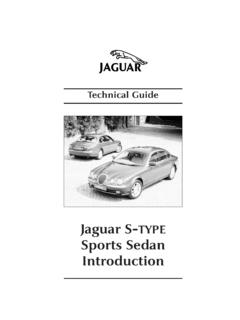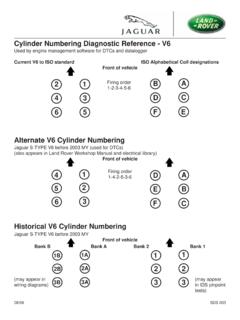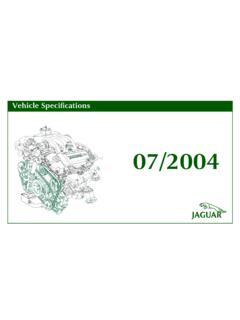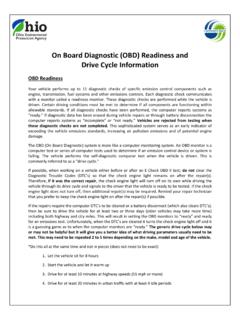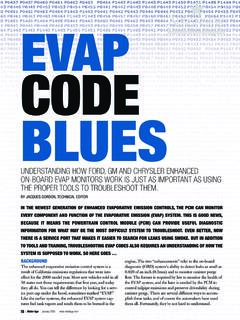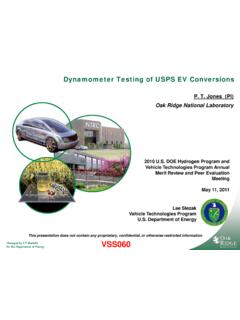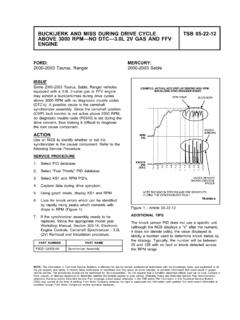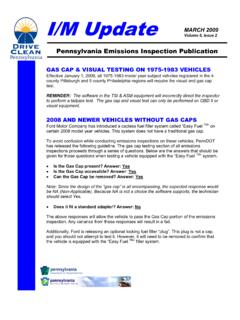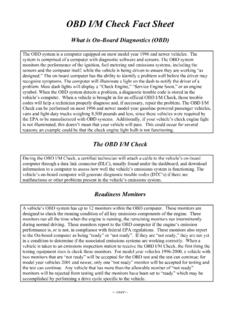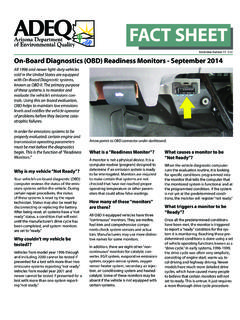Transcription of Powertrain DTC Summaries – OBD II - Jagrepair.com
1 Jaguar S - TYPE V6, V8 N/A and V8 SC 2003 Model Year Powertrain DTC Summaries OBD II Quick Reference Diagnostic Guide Jaguar S-TYPE P DTC OBD II 2003 Model Year Refer to pages 2 9 for important information regarding the use of Powertrain DTC Summaries .REFERENCE: It is recommended that the applicable Electrical Guide be referenced when using the information contained in this document. Revised August, 2002: P0507, P0532, P0533, P1260 Jaguar S-TYPE P DTC OBD II 2003 Model Year 2 KEY TO COLUMN HEADINGS DTCD iagnostic Trouble Powertrain system with which the DTC is associated EMS (ALL SYSTEMS), V6 EMS, V8 EMS, V8 SC EMS, TRANS, retrieval tools:OBD II indicates that the DTC is an OBD II code and can be accessed via a generic scan tool or indicates that the DTC is not an OBD II code and is accessed only via DESCRIPTIONF ault CONDITIONS DIAGNOSTIC MONITOR drive cycle for the particular DTC.
2 Operate the vehicle as described to check for a reoccurrence of the DTC. Refer to pages 4 8. Use WDS Datalogger or Scan Tool to monitor specified engine parameter(s).CHECK ENGINE MIL11 TRIP indicates that the CHECK ENGINE MIL is activated by a fault occurring during ONE TRIP .(CK ENG)22 TRIPS indicates that the CHECK ENGINE MIL is activated by a fault occurring during TWO CONSECUTIVE TRIPS .Refer to page 3 for definition of OBD TRIP .NNO indicates that the CHECK ENGINE MIL is not Warnings:N = NoneR = RED MIL (warning lamp) plus Message Center messageA = AMBER MIL (warning lamp) plus Message Center messageC = Charge indicatorDEFAULT ACTIONC ontrol Module default action:Logged DTC stored in ECM memory buffer; Flagged DTC stored in ECM memory / CHECK ENGINE MIL PINECM (system Engine Management System) / TCM (system Transmission) connector pin number(s)POSSIBLE CAUSES Possible causes are listed in the order of diagnostic VOLTAGE High voltage can be either sensor supply voltage (5 volts) or B+ voltage.
3 Jaguar S-TYPE P DTC OBD II 2003 Model Year 3 21436587 214365 CYLINDER NUMBERING Engine cylinder numbering is as follows: OBD SYSTEM READINESS ENGINE MANAGEMENT If DTC P1000 is flagged after DTCs have been cleared, all engine management OBD diagnostic monitor drive cycles HAVE NOT BEEN COMPLETED. If DTC P1111 is flagged after DTCs have been cleared, all engine management OBD diagnostic monitor drive cycles HAVE BEEN COMPLETED. OBD SYSTEM READINESS TRANSMISSION Use WDS Datalogger TOTAL NUMBER OF DTC SET to determine if transmission OBD monitoring has been completed. OBD TRIPS The OBD system defines 1 TRIP as an ignition cycle (ignition key OFF; wait 30 seconds; ignition key ON) plus a minimum engine coolant temperature increase of 22 C (40 F) after which, the engine coolant temperature has to reach a minimum of 71 C (160 F).
4 Jaguar S-TYPE P DTC OBD II 2003 Model Year 4 OBD DIAGNOSTIC MONITORS The Engine Management and Transmission Control systems are continuously checked during vehicle operation by the Engine Control Module (ECM) and Transmission Control Module (TCM) on-board diagnostic (OBD) facilities. Powertrain OBD incorporates seven diagnostic monitors. Each monitor has an associated group of DTCs. The diagnostic monitors will complete the diagnostic test(s) if a specified service drive cycle is carried out. The seven diagnostic monitors are as follows: Heated Oxygen Sensors Monitor Adaptive Fuel Monitor Misfire Monitor Catalyst Efficiency Monitor Evaporative System Monitor Exhaust Gas Recirculation Monitor Comprehensive Component Monitor (Engine Management / Transmission) DIAGNOSTIC MONITORS drive CYCLES Technicians can ensure that an OBD Monitor drive cycle is completed and that all or specific components have been checked by completing a specified drive cycle .
5 Use the following service drive cycles to confirm that the components and subsystems covered by the Diagnostic Monitors are operating correctly. Jaguar S-TYPE P DTC OBD II 2003 Model Year 5 HEATED OXYGEN SENSORS MONITOR drive CYCLEU pstream (Universal) oxygen sensors: 1 Engine OFF; cooling fans inoperative > 20 engine and bring to normal operating temperature > 82 C (180 F).3 drive the vehicle between 3000 4000 rpm in 3rd gear at a steady speed. Lift foot completely off accelerator and coast to a stop within 30 seconds. Do not touch accelerator pedal for 4 seconds after coming to a stop. 4 Repeat step engine for 11 minutes. Downstream oxygen sensors: 1 Start engine and bring to normal operating temperature > 82 C (180 F).2 drive the vehicle steadily between 48 97 km/h (30 60 mph) for 10 the vehicle above 3000 rpm in 3rd gear at a steady speed.
6 Lift foot completely off accelerator and coast for 30 seconds. Oxygen sensor heaters: 1 Start engine and bring to normal operating temperature > 82 C (180 F).2 Idle engine for 3 minutes. ADAPTIVE FUEL MONITOR drive cycle 1 Start engine and bring to normal operating temperature > 82 C (180 F).2 Idle for a minimum of 10 minutes. Jaguar S-TYPE P DTC OBD II 2003 Model Year 6 MISFIRE MONITOR drive cycle 1 Record flagged DTC (s) and accompanying WDS DTC Monitor freeze frame(s) level > 25%.3 Start the engine at a coolant temperature lower than the recorded freeze frame value (from Step 1).4 drive the vehicle to the recorded freeze frame conditions for 4 minutes. If CHECK ENGINE MIL flashes, lower the engine speed until the flashing stops. Note regarding misfire monitor DTCs: If, on the first trip, the misfire is severe enough to cause excess exhaust emission, the individual cylinder DTC plus DTC P1316 will be logged.
7 The CHECK ENGINE MIL will not be activated. If the fault reoccurs on the second trip, the individual cylinder DTC plus DTC P1316 will be flagged, and the CHECK ENGINE MIL will be , on the first trip, the misfire is severe enough to cause catalyst damage (more severe than excess exhaust emission), the CHECK ENGINE MIL will flash while the fault is present and the individual cylinder DTC plus DTC P1313 (bank 1), DTC P1314 (bank 2) will be logged. When the fault is no longer present the MIL will be deacti-vated. If the fault reoccurs on the second trip, the CHECK ENGINE MIL will flash while the fault is present and the individual cylinder DTC plus DTC P1313 (bank 1), DTC P1314 (bank 2) will be flagged. When the fault is no longer present the CHECK ENGINE MIL will be activated.
8 CATALYST EFFICIENCY MONITOR drive cycle 1 Start engine and bring to normal operating temperature > 82 C (180 F).2 drive the vehicle in a steady state condition between 1300 3000 rpm without stops or starts for a minimum of 5 minutes. Jaguar S-TYPE P DTC OBD II 2003 Model Year 7 EVAPORATIVE SYSTEM MONITOR drive cycle (OBD II ONLY) 1 Ensure that fuel filler cap is fully closed (minimum three clicks).2 Fuel level > 30% and < 85%.3 Using WDS, perform ECM DTC Clear (even if no DTCs are flagged).4 drive vehicle for a minimum of 2 minutes, and until engine is at normal operating WDS, ensure that the EVAP Canister Purge Valve is operating by observing PURGE VAPOR MANAGEMENT VALVE DUTY cycle . If the valve is not active, ECM adaptions have not been learned.
9 Conduct a green ECM drive cycle as described in Technical Service vehicle to the road where the EVAP System drive cycle will be conducted. Stop vehicle and switch OFF the ignition. Leave ignition OFF for 30 seconds, then restart the briskly to 80 km/h (50 mph) ensuring that the engine speed reaches a minimum of 3500 rpm for a minimum of 5 ( inch EVAP Test) View WDS PURGE VAPOR MANAGEMENT VALVE DUTY cycle , CANISTER CLOSE VALVE VAPOR RECOVERY SYSTEM , and FUEL TANK PRESSURE VAPOR RECOVERY SYSTEM . Avoiding high engine loads, drive the vehicle steadily between 65 km/h (40 mph) and 100 km/h (60 mph). Avoid driving conditions that will produce excessive fuel movement. WDS should give an indication that the test is active (it may take up to 30 minutes before the test will initialize).
10 When the test has initialized (EVAP Canister Close Valve CLOSED), it will take approximately 90 seconds for the test to ( inch EVAP Test) Continue driving vehicle as explained in Step 8 for an additional 10 minutes. 10 Gently coast the vehicle to a stop. Allow the engine to idle for 2 minutes and view WDS PURGE VAPOR MANAGEMENT VALVE DUTY cycle , CANISTER CLOSE VALVE VAPOR RECOVERY SYSTEM , and FUEL TANK PRESSURE VAPOR RECOVERY SYSTEM . WDS should give an indication that the test is active. When the test has initialized (EVAP Canister Close Valve CLOSED), it will take approximately 90 seconds for the test to the inch EVAP Test is not activated, the purge system vapor concentration may be too great. To reduce the vapor concentration proceed as follows: 12 drive the vehicle for an additional 30 minutes avoiding driving conditions that will produce excessive fuel movement.

